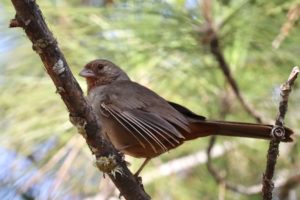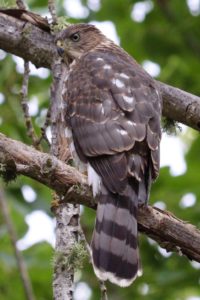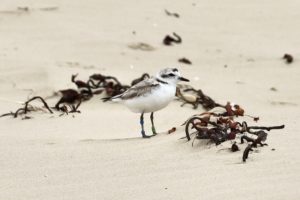It started with a pandemic. And a bird fluttering by my office window. Back and forth in my line of sight, distracting me from whatever seemed more important at the time. Paying bills or googling how to fix a running toilet. Or maybe I was making a to-do list—trying to figure out how to fill my days while sheltering in place.
It was serendipitous, that bird, hopping along the top of the fence. With so much time on my hands and nowhere to go, I took to leaving the binoculars and my camera out on the desk.
As it turns out, it was a lively California towhee. A curious, social bird, brown with a tinge of cinnamon on its tail and a single, insistent chirp, chirp, chirp. They’re quite common and I started seeing them all over. I’m not sure how I’d missed noticing them before.
Lately, I’ve been hearing a cacophony of sounds from my patio. But for the squawking crows and the sweet, melodious song of the white-crowned sparrows, I haven’t learned to identify their calls—at least not yet.
But this morning I heard what were unmistakably distress calls. There in the tree above my patio was a Coopers hawk quietly posing for me while neighboring birds sounded the alarm. There’s a whole lot of drama out there—if only we’re prepared to notice.
In the trees adjacent to my house, I’ve identified flycatchers and chickadees, a white-tailed hawk, a Nuttall’s woodpecker, cedar waxwings feasting on red toyon berries, black-eyed juncos scratching at the ground. Yesterday I came upon a flock of bushtits—fluffy balls of brown and gray twittering in the bushes.
Snowy Plovers: A COVID Silver Lining?
Given that it’s summertime, I’ve taken to walking a section of beach normally overrun with off-roaders. Due to COVID-19, the area’s been closed to vehicles, and the beach is suddenly, stunningly peaceful. It seems to me that the birds are at least as happy as I am with the misty mornings, the tranquil undulation of the waves, the unfettered expanse of quiet.
The area is home to western snowy plovers and California least terns, endangered birds that nest in shallow indentations in the sand. Recently, California State Parks and Recreation was found to be scuffing out their nests and putting up mylar streamers to scare away the birds—all in an effort to make it possible for the dune buggies and ATVs to return once the coronavirus restrictions are lifted.
The Coastal Commission caught wind of what they were doing and called a halt to it—at least until the end of September when snowy plover breeding season is over. What they were doing is, after all, a violation of the Endangered Species Act.
I’m afraid that whatever happens next will have less to do with the wildlife. And more to do with the vociferous lobbying of off-road enthusiasts. The off-roaders will tell you that the Coastal Commission has already significantly restricted their range for recreating. But I feel greedy for the plovers—sweet little birds, who shouldn’t have to depend on the kindness of an indecisive bureaucracy for their survival.
In the meantime, I’m taking advantage of the quiet on that section of beach. I’ve seen great blue herons and egrets, black-crowned night herons, whimbrels and willets, godwits, gulls and pelicans. And yes, I was lucky enough to spot a few plovers scurrying across the sand.
So while the health of our country is all-too-scary to contemplate, I’m in the enviable position of being able to nest in place. I miss traveling, of course. And who knows when that’ll be safe again? In the meantime, I’ve discovered a whole other world out there. Right in my own backyard.
I invite you to read related blogs including Iceland: How Adversity Might Save the Planet and Thin Places: The Possibility of Transformation. And my novel, Thin Places, that is available on Amazon in paperback and Kindle.



